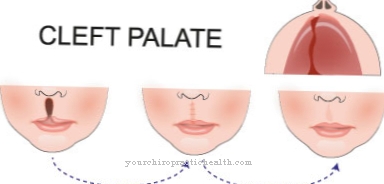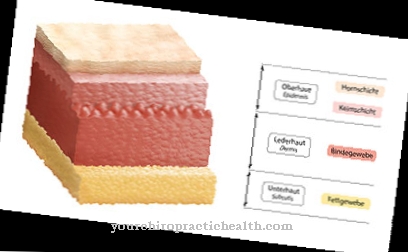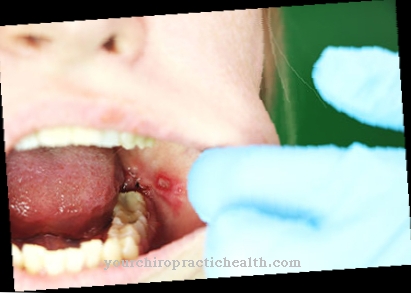In the Aspiration pneumonia it is a special form of pneumonia. In most cases it arises from the fact that foreign material is inhaled and the defense system of the airways is inadequate. Usually, aspiration pneumonia occurs in the basal sections of the lungs.
What are aspiration pneumonia?

© Vladislav Gajic - stock.adobe.com
Aspiration pneumonias are characterized by the fact that they arise from aspiration of foreign bodies and liquids. Mendelson's syndrome is a special form of aspiration pneumonia, in which the pneumonia occurs after gastric juice has penetrated the airways. This can happen during the process of vomiting up food.
If foreign bodies enter the lungs via the airways when eating or vomiting, pathogens are transported into the respiratory system. These sometimes trigger inflammation in the lungs, which can lead to aspiration pneumonia. For this reason, aspiration pneumonia is what is known as 'inhaled' pneumonia.
causes
Aspiration pneumonia occurs as a result of the inhalation of foreign objects into the lungs. Normally, the airways are protected by certain reflex mechanisms so that neither food particles nor gastric juice can get into the airways and from there to the lungs when eating or vomiting.
If such a case nevertheless occurs, a cough reflex occurs as a result of the swallowing, which removes the foreign material from the airways before it can be transported into the lungs. However, there are situations in which the reflex system does not function properly. The protective reflexes sometimes fail, especially in older people or those who suffer from certain diseases.
The cough reflexes can also be impaired in the context of unconsciousness, such as alcohol or drug poisoning. If the affected person swallows or vomits without activating the cough reflexes, food components or gastric juice can get into the lungs.
This transports pathogens into the lungs that can cause inflammatory processes. When gastric juice is swallowed, there is a special case of aspiration pneumonia, whereby the acid irritates the sensitive lung tissue through chemical burns.
Symptoms, ailments & signs
Aspiration pneumonia is associated with various characteristic symptoms and complaints. Aspiration usually results in severe coughing and increased mucus production in the bronchial mucosa. Such signs are often at the beginning of the disease.
Pneumonia often develops later and is accompanied by rapid breathing (the medical name is tachypnea). Fever and a general feeling of illness set in. Depending on the severity of the aspiration pneumonia, shortness of breath can be an additional symptom. The typical symptoms of aspiration pneumonia set in with a delay of a few hours to a few days in most cases.
The affected patients show bronchial reactions with a so-called bronchospasm and increased secretion. Shortness of breath is often accompanied by coughing with sputum. In addition, the body temperature is measurably increased. A possible shortness of breath (medical term dyspnea) can lead to a bluish or purple discoloration of the skin and mucous membranes (medical term cyanosis).
Diagnosis & course
Various examination methods are available for diagnosing aspiration pneumonia. In the first step, the attending physician discusses the recent event of swallowing or vomiting with the patient. As a first exam, the doctor will usually listen to the lungs with a stethoscope. Audible changes can confirm the assumption.
The diagnosis of aspiration pneumonia can be confirmed by x-ray examinations of the lungs. Changes typical of the disease are visible in the X-ray. At the same time, the extent of the inflammation can be determined. In addition, blood tests can provide information about the oxygen content of the blood, with which it is possible to determine the oxygen uptake through the lungs.
Other diagnostic methods are lung specimens or bronchoscopies, which allow a direct view of the lungs. The aspirated material can be found during a lung specimen or bronchial lavage. Computed tomography can also be used to diagnose aspiration pneumonia.
Complications
Aspiration pneumonia is a dreaded complication resulting from inhaling a foreign body. In the case of small children, the object can constrict the windpipe so much that the child cannot breathe and suffocates. In adults, too, inhalation leads to severe shortness of breath and an urge to cough.
The most dreaded complication of aspiration pneumonia is lung failure (respiratory failure). The patient can no longer absorb enough oxygen or release carbon dioxide, he suffers from a severe lack of oxygen, which can be life-threatening. It is also life-threatening if the inflammation spreads over the entire body and thus causes sepsis.
This can end in septic shock, which can then lead to multiple organ failure. In addition, a lot of fluid collects in the pleura due to the inflammation (pleural effusion), which also affects breathing. Pus can also accumulate in the pleural cavity (pleural empyema), causing the lungs to stick together with the pleura.
If the inflammation persists for a long time, scarring of the lung tissue (pulmonary fibrosis) can occur, which impairs the expansion of the lungs and thus also affects breathing. A widening of the bronchi is also conceivable (bronchiectasis), which favors further inflammation and leads to frequent bleeding in the lungs.
When should you go to the doctor?
Since aspiration pneumonia has a very negative effect on the lungs and breathing of the person affected, a doctor must be consulted in any case. If there is no treatment, aspiration pneumonia can, in the worst case, lead to death of the person concerned.
The doctor should then be seen if the person coughs heavily or produces an increased amount of mucus for no specific reason. It can also lead to a fever and general tiredness and fatigue in the patient. Shortness of breath is also a symptom of aspiration pneumonia and must be examined by a doctor.
In an acute emergency, the person concerned can also contact a hospital or an emergency doctor. There is also a cough with sputum and in some cases the skin turns blue. If the skin is already turning blue, an emergency doctor must be called, as this can also damage the internal organs if they are not supplied with enough oxygen.
The first visit is usually made to a general practitioner. In emergencies, however, you must always go to the hospital directly or call the emergency doctor in order to avoid further complications.
Doctors & therapists in your area
Treatment & Therapy
Various measures are available for the treatment of aspiration pneumonia, which are used depending on the individual clinical picture and the severity as well as the localization of the disease. First, an attempt should be made to remove the foreign material from the lungs by suction. The administration of medication to dilate the airways can make it easier to cough up the foreign body.
The bacteria underlying pneumonia are usually treated with antibiotics. The main aerobic germs are primarily staphylococci, streptococci, Pseudomonas and haemophilus. In order to alleviate the symptoms of shortness of breath, the breathing air can be enriched with oxygen via a nasal tube.
In particularly severe cases of shortness of breath, the patient must be given artificial respiration. In any case, the cause of the aspiration must be taken into account when choosing the therapy concept.
Outlook & forecast
The prognosis of aspiration pneumonia depends on various factors. These include the severity and intensity of the pneumonia, the type of bacteria that caused the disease, and the size of the affected area. In addition, the patient's age and general health should be taken into account in determining the chances of recovery.
Normally an adult person with a good immune system has a good chance of a complete cure if treated quickly and without delay. This usually occurs within a few weeks. It should be noted, however, that people who develop aspiration pneumonia often suffer from additional diseases.
These weaken the airways and only allow insufficient activity of the gag reflex and swallowing. The functional impairment ultimately leads to the development of aspiration pneumonia and reduces the prospect of a complete cure.
If no medical treatment is sought, the prognosis is poor. Lung abscesses can form, inflammation can develop and the function of the airways can be restricted. An acute failure of the respiratory function is a fatal course of the disease. The size of the foreign body in the lungs is responsible for the amount of tissue damage. After the foreign body has been removed, some patients require permanent artificial ventilation.
prevention
In order to prevent the development of aspiration pneumonia, potential causes should be considered and avoided if possible. Accordingly, when eating, special attention should be paid to the swallowing process in order to prevent foreign bodies from entering the airways.
Even if you vomit, you should make sure that the acidic gastric fluid does not get into the windpipe. If possible, someone else should be involved in the event of aspiration of food or gastric juice, and an emergency doctor should be contacted in the event of complications.
Aftercare
Most patients with a healthy immune system can get rid of a disease completely. It is important for them to prevent recurrence. You are responsible for this yourself. Preventive measures include paying sufficient attention to swallowing while eating and drinking. Patients who vomit should be careful not to allow gastric fluids to get into the windpipe.
If the typical symptoms occur, it is essential to consult a doctor. Sometimes sage tea and other naturopathic remedies help to speed recovery. According to the current state of science, immunity is not given after a single illness. Patients can therefore get infected again and again. Possible complications should not be underestimated.
They often cause long-term damage. The failure of the lungs in particular can have life-threatening consequences. The brain as the center of human activity can be so strongly attacked that various basic abilities are lost.
Inpatient therapy involves the removal of fluids and foreign bodies. The secretion is regularly examined microbiologically in order to initiate a suitable form of therapy. Doctors administer antibiotics to destroy the pathogen. The progress of the recovery or the illness can be clearly demonstrated using x-rays.
You can do that yourself
Aspiration pneumonia can be life-threatening if it is not treated professionally in a timely manner. Sick people must therefore consult a doctor.
One of the most important contributions to self-help is making it easier for the doctor to diagnose. Anyone who notices symptoms of suspected flu after foreign bodies or stomach acid have gotten into the lungs should definitely inform the attending physician about these incidents.
The same applies if water accidentally gets into your lungs while swimming or in an accident. The doctor can then examine the patient in a targeted manner and identify and treat possible pneumonia in good time. Long-term damage to the respiratory organs is then usually not to be feared.
People who have a tendency to swallow frequently should learn to eat slowly and with concentration, as the risk of aspiration pneumonia increases with each of these incidents. Even those who constantly suffer from acid regurgitation should get this problem treated promptly to prevent damage to the lungs.
If aspiration pneumonia has developed, those affected can fight some of the symptoms with mild home remedies. However, this should only be done in addition to the medically prescribed therapy. Cold calf compresses help against the frequently occurring high fever. Sage and ribwort are used in natural medicine to counteract the increased production of mucus and strong coughs.




.jpg)







.jpg)



.jpg)










.jpg)
